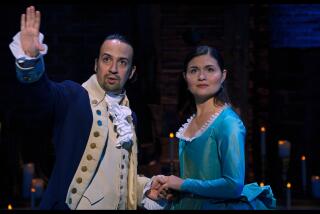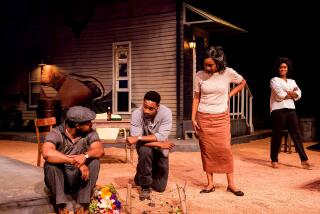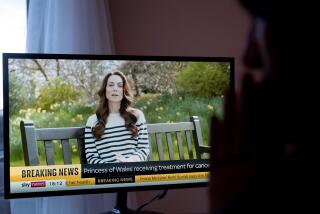Perspective: How true is ‘The King’s Speech’?
- Share via
If any best-picture contender was going to face questions about taking liberties with the facts this Oscar season, it seemed likely it would be “The Social Network.” But now that screenwriter Aaron Sorkin and Facebook founder Mark Zuckerberg have tactfully retreated a bit from their initially contentious stands, the accuracy debate has shifted to “The King’s Speech.”
“The King’s Speech” is being sold as a feel-good tale of how a friendship between a royal and a commoner affected the course of history. But some commentators are complaining, among other things, that the film covers up Winston Churchill’s support for Edward VIII, the playboy king who abdicated to marry an American divorcee, and that the movie fails to acknowledge that the once tongue-tied George VI supported Prime Minister Neville Chamberlain’s appeasement of the Nazis. (Writing last month at slate.com, Christopher Hitchens blasted the film as “a gross falsification of history.”)
As a specialist in British history, I agree that screenwriter David Seidler certainly has tweaked the record a bit and telescoped events in “The King’s Speech” — but for the same artistic reasons that have guided writers from Shakespeare to Alan Bennett, who wrote the screenplay for “The Madness of King George” (and the play on which the movie was based). While historians must stick to the facts, dramatists need to tell a good story in good time. It also helps if they can explore the human condition in the process.
Seidler’s script opens with Colin Firth as Prince Albert (the future King George VI, but then the Duke of York and known to his family as “Bertie”) facing the ordeal of making his first radio broadcast. To add to the strain, the duke must deliver the address in a stadium before a large crowd. However, his words come only haltingly, causing embarrassment for all present. Not shown but later referenced in the film is the fact that in the crowd was Lionel Logue (Geoffrey Rush), a speech therapist recently transplanted from Australia.
All this took place in 1925, but Seidler brings the speech disaster forward 10 years to the eve of the abdication crisis, which resulted in the duke unexpectedly being transformed into a king when his brother Edward VIII stepped aside. The compression of events, although understandable, requires a slew of historical alterations to explain the back story.
The duke’s stammer derived in part from the verbal abuse he received as a child from his father, King George V (Michael Gambon). To indicate this, Seidler concocts a scene showing the adult Bertie still being hectored by his father, and it is only after this that he agrees to see Logue.
Much of the early part of the film is taken up with Logue’s struggle to win the duke’s trust. The therapist succeeds partly by trickery and partly because of continued prompting by Bertie’s wife, the Duchess of York (Helena Bonham Carter). After achieving a “breakthrough” with his patient and following Edward’s abdication in 1936, Logue helps prepare the new king for the ordeal of the coronation ceremony. That hurdle cleared, the film culminates with the therapist coaching Bertie through another historic moment: his broadcast to the British Empire at the start of World War II with an approving Churchill (Timothy Spall) looking on.
In reality, the duke first sought treatment from Logue in 1926, and, contrary to the film, the two hit it off immediately. Logue wrote in a note later published in the king’s official biography that Bertie left their first meeting brimming with confidence. After just two months of treatment, the duke’s improvement was significant enough for him to begin making successful royal tours with all the public speaking that entailed. George V was so delighted that Bertie rapidly became his favored son and preferred heir.
In interviews, Seidler has been ambiguous about what sources he consulted in writing the script. The various biographies of George VI all tell of the king’s relationship with Logue. This includes the official biography published in 1958. John Wheeler-Bennett, the royal biographer personally selected by the king’s widow, was himself a former patient of Logue’s and so wrote about the episode with great emotion.
It remains unclear, though, to what extent sources not available to scholars or the public played a role in the final shape of the film. Seidler has said that Logue’s son offered 30 years ago to show him his father’s notebooks, provided the king’s widow agreed. But when Seidler wrote Queen Elizabeth, the Queen Mother, he was told that she found it too painful to remember the old anguish and begged that he wait until she had passed away.
Although the Queen Mother died in 2002, filmmakers said they were provided with Logue’s diaries, notes and letters only shortly before filming began. Seidler has not specified how material from Logue’s records was used, but he has said that research guided him to the conclusion that Logue utilized Freud’s “talking cure” approach. Thus, by reading up on the king’s life, Seidler used what he terms “informed imagination” to create the film’s therapy scenes.
Seidler also drew on personal experience: He himself stammered as a child, and it was this that led him to an interest in George VI. From what he has said about his own successful treatment, Seidler indicates that he projected that experience into his fabrication about Logue having to work patiently to gain Bertie’s trust. This liberty with the truth certainly gives the film more dramatic interest.
There are many other instances of artistic license in “The King’s Speech.” For example, Bertie chose his regal cognomen, George, out of respect for his father and not as the film has it because Churchill suggested that Albert sounded “too German.” Another dramatic fantasy occurs when the Archbishop of Canterbury (Derek Jacobi) breathlessly revealed that Logue was not in fact a doctor. In reality, Logue’s credentials were never misrepresented. Bertie always referred to him as “Mr. Logue” or simply “Logue.” Logue’s grandchildren recently came forward to say that their grandfather never used Christian names with the king at all — despite the movie making a strong point that the future king bristled at being called “Bertie” by Logue.
As for Hitchens’ allegations, they are much ado about nothing. Churchill’s support of Edward VIII owed more to his near-medieval reverence for the monarchy than it did to the individual occupying the throne. In supporting the appeasement policies of Chamberlain, George VI acted in harmony with the overwhelming majority of the British population across the political spectrum. As a combat veteran of World War I, the king was as anxious as his subjects to avoid a second conflict by any promising means. George VI was also at one with most Britons in remaining skeptical about Churchill as prime minister until the great man had proved himself.
Hitchens will get a second chance to scrutinize moviedom’s portrayal of Edward VIII and George VI this year, when Madonna’s film “W.E.” — about Wallis Simpson and Edward — hits theaters. He’s probably already stocking up on pencils.
Freeman teaches history at California State Fullerton.
More to Read
The biggest entertainment stories
Get our big stories about Hollywood, film, television, music, arts, culture and more right in your inbox as soon as they publish.
You may occasionally receive promotional content from the Los Angeles Times.










